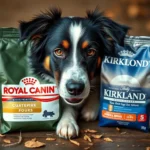
Introduction
Nutrition plays a vital role in the overall health and well-being of our canine companions. Just like humans, dogs require a balanced diet to thrive, supporting their energy levels, maintaining a healthy coat, and ensuring proper organ function. One question that often arises among dog owners is, can dogs eat anchovies? Understanding which foods are safe and beneficial for dogs is crucial, especially as we explore new options to enhance their diets. This article will delve into the nutritional aspects of dog food, the benefits and risks of feeding anchovies to dogs, and alternative protein sources.
Understanding Dog Nutrition
Basic Nutritional Needs
Dogs, like all living beings, need a balanced intake of macronutrients to maintain their health:
-
Proteins: Essential for building and repairing tissues, proteins also play a crucial role in producing enzymes and hormones. High-quality protein sources are vital for a dog’s muscle development and overall growth.
-
Fats: Fats are a concentrated energy source and are necessary for the absorption of certain vitamins. They also contribute to healthy skin and coat, making them an essential part of a dog’s diet.
-
Carbohydrates: While not strictly essential, carbohydrates are a source of quick energy. They can also provide dietary fiber, which aids in digestion.
In addition to these macronutrients, micronutrients such as vitamins and minerals are equally important. These nutrients support various bodily functions, including immunity and bone health. Lastly, water is crucial; it aids digestion, absorption, and the transportation of nutrients within the body.
Common Myths about Dog Nutrition
Several myths can cloud our understanding of dog nutrition. One common misconception is that dogs can thrive solely on a meat-based diet. While protein is vital, a balanced diet must include carbohydrates, fats, vitamins, and minerals. Another myth suggests that all human food is harmful to dogs; however, many human foods can be nutritious and safe when prepared correctly. Always consult a veterinarian for personalized dietary advice tailored to your dog’s specific needs.
Overview of Anchovies
What Are Anchovies?
Anchovies are small, saltwater fish belonging to the Engraulidae family. Known for their strong flavor and distinct aroma, they are commonly used in various culinary dishes, ranging from pizzas to Caesar salads. Nutritionally, anchovies are rich in protein and packed with essential fatty acids, making them an intriguing option for supplementing a dog’s diet.
Nutritional Benefits of Anchovies
Anchovies boast several nutritional benefits that can be advantageous for dogs:
-
Rich in Omega-3 Fatty Acids: These essential fats promote heart health, reduce inflammation, and support cognitive function. Omega-3s can also enhance skin and coat health, giving your dog a shiny appearance.
-
High Protein Content: With about 20 grams of protein per 100 grams, anchovies provide a significant protein source that supports muscle growth and maintenance.
-
Vitamins and Minerals: Anchovies contain essential vitamins (like Vitamin A and Vitamin D) and minerals (such as calcium and iron) that contribute to your dog’s overall health.
Can Dogs Eat Anchovies?
Safety Considerations
While dogs can eat anchovies, it’s essential to consider certain safety factors. One primary concern is the salt content found in many commercially available anchovy products. High sodium levels can lead to health problems in dogs, including increased thirst and urination, and in severe cases, sodium ion poisoning. Therefore, it’s crucial to choose low-sodium options or prepare fresh anchovies without added salt.
Additionally, anchovies contain small bones that could pose a choking hazard or cause digestive issues. Always ensure that the anchovies are deboned before feeding them to your dog. Lastly, some dogs may have allergies or sensitivities to fish, so it’s important to monitor your pet for any adverse reactions when introducing new foods.
How to Safely Introduce Anchovies to a Dog’s Diet
To safely introduce anchovies into your dog’s diet, follow these guidelines:
-
Recommended Serving Sizes: Start with a small amount, such as a quarter of an anchovy for smaller breeds and one anchovy for larger breeds. Observe how your dog reacts before increasing the serving size.
-
Preparation Tips: Fresh anchovies are the best option. If using canned or dried anchovies, ensure they are packed in water with no added salt. Rinse them thoroughly before serving to minimize sodium intake.
-
Signs to Watch For: When introducing any new food, watch for signs of allergies or digestive upset, such as vomiting, diarrhea, or unusual lethargy. If any of these symptoms occur, discontinue feeding anchovies and consult your veterinarian.
Benefits of Feeding Anchovies to Dogs
Feeding anchovies can offer several health benefits for dogs:
-
Skin and Coat Health: The Omega-3 fatty acids in anchovies can help alleviate dry skin and promote a healthy, shiny coat.
-
Joint Health: Omega-3s can also support joint health, potentially benefiting older dogs or those with arthritis.
-
Enhanced Palatability: If your dog is a picky eater, incorporating anchovies into their food can make meals more appealing, encouraging them to eat.
Alternatives to Anchovies
Other Fish Options
If you’re considering fish as a protein source for your dog, several alternatives are available:
-
Salmon: Rich in Omega-3 fatty acids and protein, salmon is a great option when cooked and served without bones.
-
Sardines: Like anchovies, sardines are packed with Omega-3s and are usually available in canned forms. Opt for low-sodium varieties.
-
Trout: This fish is another excellent source of protein and healthy fats. Ensure it’s fully cooked and deboned before serving.
Nutritional Comparisons
| Fish Type | Protein Content (per 100g) | Omega-3 Content |
|---|---|---|
| Anchovies | 20g | 2,200mg |
| Salmon | 25g | 2,260mg |
| Sardines | 25g | 1,480mg |
| Trout | 20g | 1,300mg |
Non-Fish Protein Sources
For those who prefer non-fish options, consider these protein-rich foods suitable for dogs:
-
Chicken: A lean source of protein that is easily digestible and highly palatable.
-
Beef: Rich in iron and B vitamins, beef can be a great addition to your dog’s diet.
-
Eggs: A complete protein source that also provides essential fatty acids and vitamins.
Pros and Cons of Each Option
| Protein Source | Pros | Cons |
|---|---|---|
| Chicken | Lean, digestible, versatile | Allergies in some dogs |
| Beef | Rich in iron and vitamins | Higher fat content |
| Eggs | Complete protein, nutritious | Risk of salmonella if raw |
Consulting a Veterinarian
Importance of Professional Guidance
When considering dietary changes for your dog, consulting a veterinarian is crucial. They can provide personalized advice based on your dog’s individual health needs and dietary requirements. If you’re unsure about introducing anchovies or any new food, your vet can help assess potential risks and benefits.
Understanding Individual Dog Needs
Each dog is unique, and their nutritional needs can vary based on breed, age, weight, and existing health conditions. For example, active breeds may require higher protein and fat levels, while older dogs might benefit from diets lower in calories but rich in nutrients. Tailoring your dog’s diet to meet their specific needs can significantly enhance their quality of life.
Conclusion
In summary, the question can dogs eat anchovies? can be answered with a resounding yes, provided certain precautions are observed. Anchovies offer numerous nutritional benefits, including high protein and Omega-3 fatty acid content, which can support your dog’s overall health. However, it’s essential to consider safety concerns, such as salt content and potential allergies.
Always seek the advice of a veterinarian before making significant changes to your dog’s diet, ensuring that your furry friend receives the balanced nutrition they need to thrive. Prioritizing a safe and nutritious diet will not only enhance your dog’s health but also strengthen the bond you share with them.









